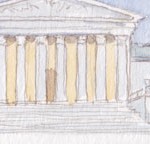Government seeks clarity on remedy after recent bankruptcy decision

Share
The Petitions of the Week column highlights a selection of cert petitions recently filed in the Supreme Court. A list of all petitions we’re watching is available here.
Last summer, the Supreme Court ruled in Siegel v. Fitzgerald that a 2017 law permitting debtors in bankruptcy proceedings in North Carolina and Alabama to pay lower administrative fees than those paid by debtors in other states violated the Constitution’s requirement that Congress provide uniform bankruptcy laws nationwide. That decision left open the question of what, if anything, to do about the debtors who had paid the higher fees. This week, we highlight cert petitions that ask the court to consider, among other things, whether the solution is simply to make the fees uniform going forward, or instead to give a refund to debtors who paid higher fees in the past.
The United States has 94 districts for bankruptcy proceedings in federal court. Most of those districts operate under the United States Trustee Program, housed in the Department of Justice. Six districts, however – those in Alabama and North Carolina – are grandfathered into a different system called the Bankruptcy Administrator Program that is overseen directly by the courts.
Bankruptcy proceedings can often be lengthy and therefore expensive to administer. The trustee program is funded by fees, most of which are paid by companies that file for bankruptcy under Chapter 11 of the Bankruptcy Code, which provides for reorganization. The law that the court struck down in Siegel required a significant five-year increase in fees to make up for a shortfall in funding for the trustee program; however, the federal judiciary, which sets fees for the administrator program, did not raise its fees at the same time, leading to sometimes substantial disparities between the two programs.
In 2016, a group of companies affiliated with John Q. Hammons Hotels and Resorts filed for bankruptcy. Because the proceedings took place in Kansas, the companies paid the regular administrative fees for the trustee program. In 2020, they asked the bankruptcy court for a partial refund, on the ground that the discrepancy between the fees for the trustee program and the administrator program violated the Constitution.
The bankruptcy court rejected that request, but the U.S. Court of Appeals for the 10th Circuit reversed. The court of appeals agreed with the companies that charging debtors in trustee districts higher fees was unconstitutional. And because it could not issue a ruling that increased the fees in Alabama and North Carolina, the 10th Circuit agreed that the solution was for the government to refund the companies the difference between the fees that they paid and what they would have paid under the administrator program.
The government appealed that ruling to the Supreme Court in early 2022, asking the justices to hold its petition for the court’s decision in Siegel and then send the case back to the 10th Circuit. The court did so last June.
Looking at the case once more, the 10th Circuit reissued its prior ruling without elaboration. Although the decision in Siegel ultimately endorsed the 10th Circuit’s reasoning on uniformity, it said nothing about a remedy for the constitutional violation, because the court of appeals in that case had not addressed the question. In light of that silence, the 10th Circuit reinstated its decision ordering a partial refund.
In Office of the United States Trustee v. John Q. Hammons Fall 2006, LLC, the government asks the justices to grant review and decide what, if any, remedy the companies are entitled to. The government argues that the justices rarely grant requests for retroactive relief, and they should not do so here. That is especially so, the government contends, when Congress made clear that it only intended to provide a remedy going forward by amending the law that the court ultimately struck down in Siegel to require administrator districts to charge debtors the same fees as those levied in trustee districts, with no mention of providing a refund to debtors in trustee districts who had paid higher fees in the past.
A list of this week’s featured petitions is below:
Stirling v. Stokes
22-1234
Issues: (1) Whether the U.S. Court of Appeals for the 4th Circuit defied this court’s remand instruction and circumvented 28 U.S.C. § 2254(e)(2)’s limitations on federal-court authority by finding forfeiture based on the state not having offered the statutory argument as an alternative ground to deny relief on the claim when the state was defending on appeal the district court’s sole finding of default; and (2) whether, if the state did forfeit its argument, the 4th Circuit erred in granting relief on a defaulted ineffective-assistance-of-trial-counsel claim by violating basic principles of Strickland v. Washington that require reviewing courts to afford deference to reasonable strategy and that the whole of the evidence be considered in a prejudice analysis.
Office of the United States Trustee v. John Q. Hammons Fall 2006, LLC
22-1238
Issue: Whether the appropriate remedy for the constitutional uniformity violation found by this court in Siegel v. Fitzgerald is to require the United States Trustee to grant retrospective refunds of the increased fees paid by debtors in U.S. Trustee districts during the period of disuniformity, or is instead either to deem sufficient the prospective remedy adopted by Congress or to require the collection of additional fees from a much smaller number of debtors in Bankruptcy Administrator districts.
Files v. United States
22-1239
Issue: Whether Section 404 of the First Step Act authorizes district courts to impose a reduced sentence for both crack-cocaine offenses and related offenses that are part of the same overall sentence package.
The post Government seeks clarity on remedy after recent bankruptcy decision appeared first on SCOTUSblog.
